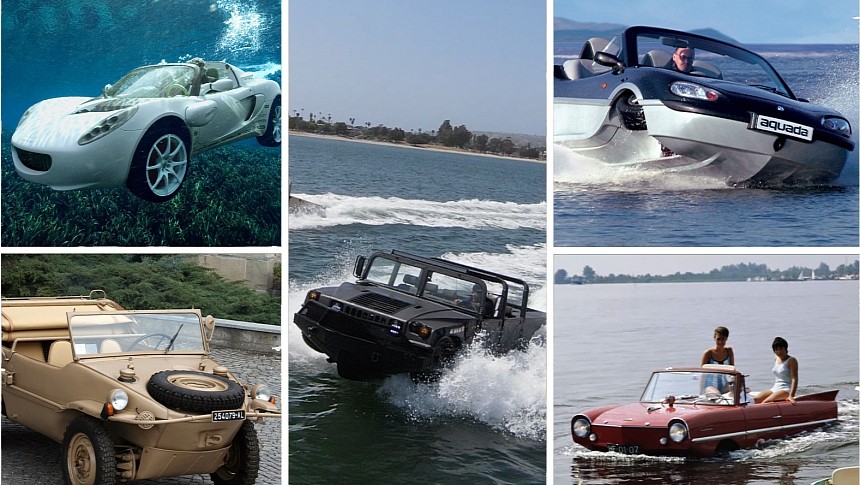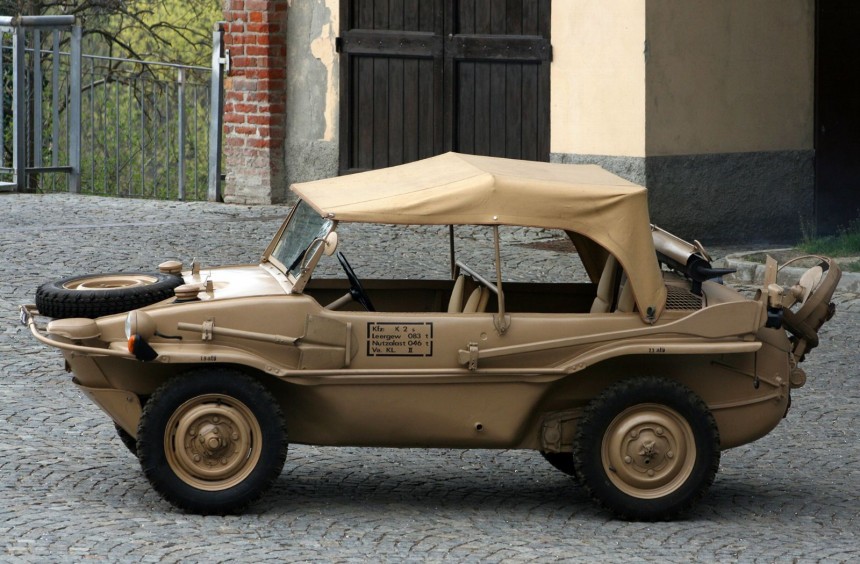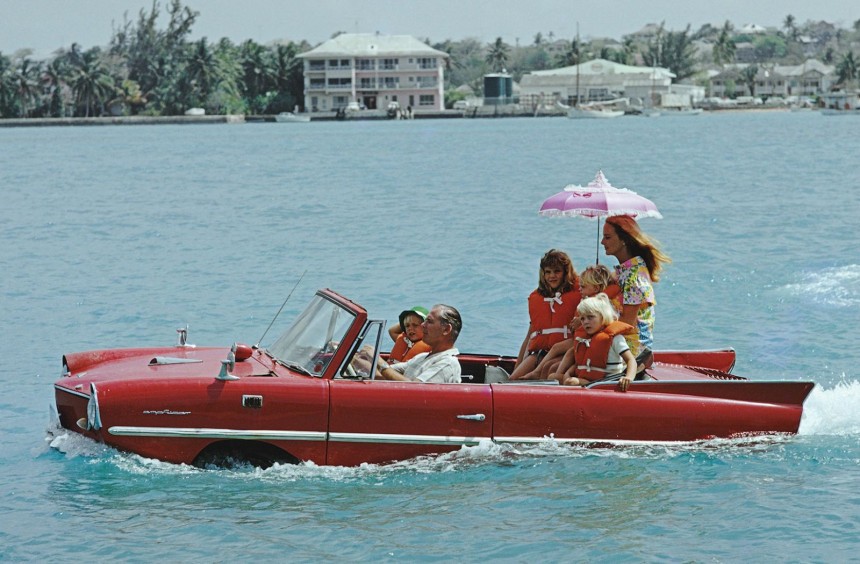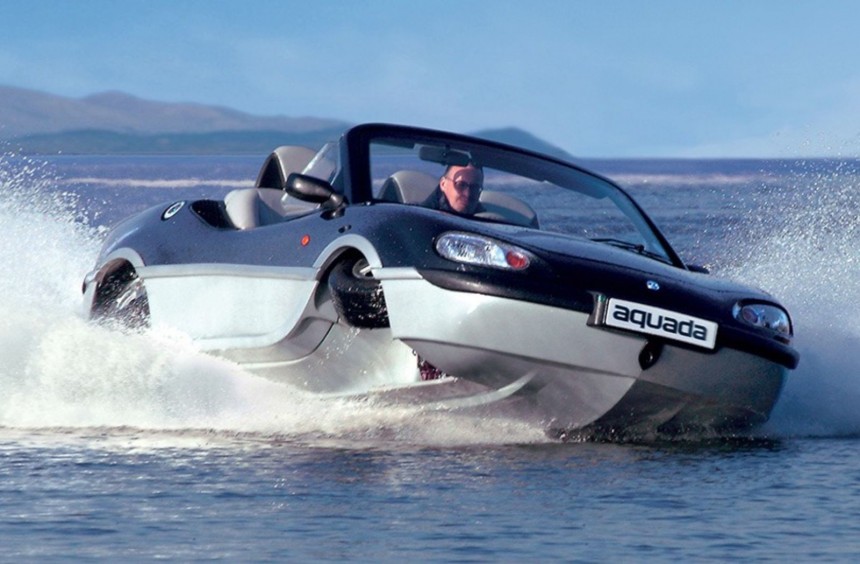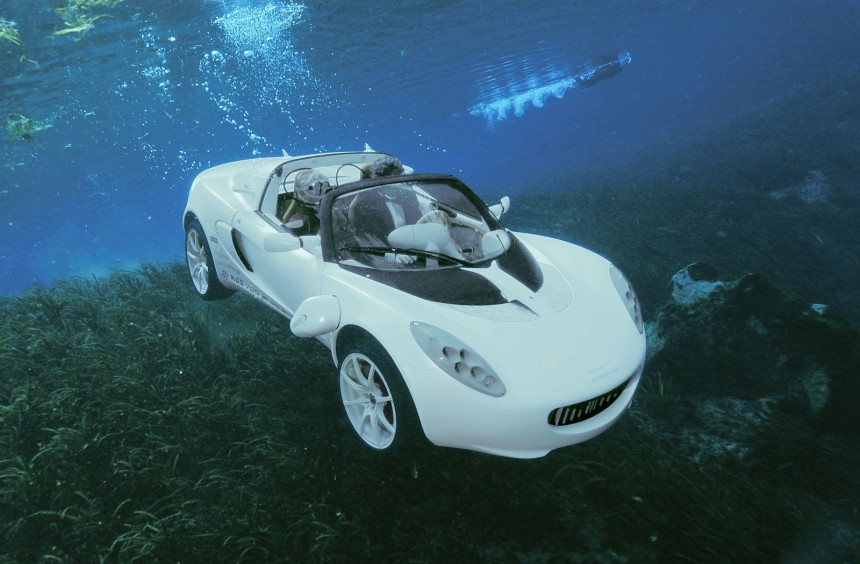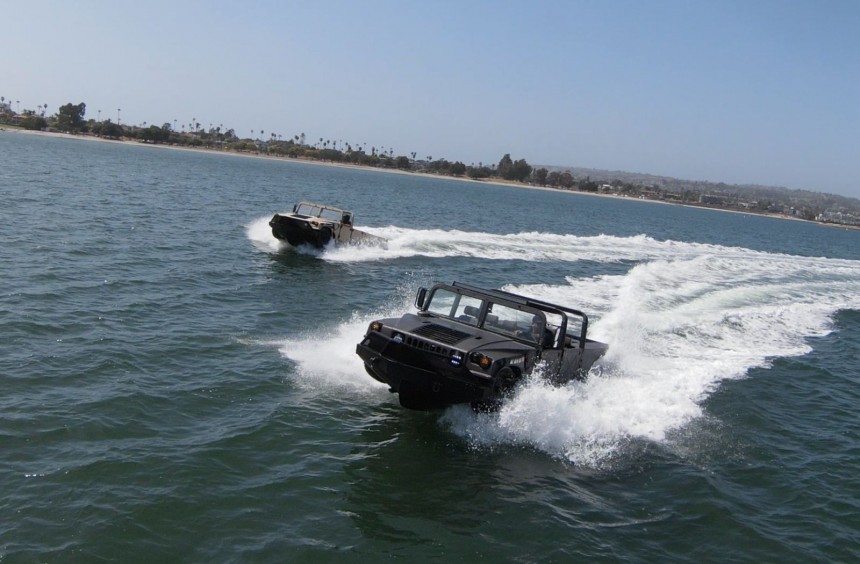Though they might look like ordinary vehicles, these awesome amphibians can cruise on open roads and waters. Even more impressive, one of them can even dive!
Contrary to what you might believe, amphibious vehicles are not new. The concept was experimented with as far back as the late 1900s when several pioneers built amphibious carriages.
With the emergence of the internal combustion engine, amphibious carriages became motorized. During the Second World War, they were widely used by several countries on both sides of the conflict.
After WWII concluded, the idea gained traction for civilian use, which led to the development of some awesome amphibious cars.
Since I mentioned the amphibious vehicles of the Second World War, it's only right to start with the most widely-produced of them all.
Codenamed Type 166, the Schwimmwagen (swimming car, in German) entered production in 1941 and was used extensively by German ground forces.
It was based on a modified chassis from the Kübelwagen prototype, which, in turn, was based on the venerable Type 1 Beetle.
Fitted with a sturdy hull, it was powered by a 25-hp flat-four connected to a propeller and featured a 4WD system with self-locking differentials.
During a production that spanned over two full years, the Schwimmwagen was built in no less than 14,276 units, 1,308 of which were assembled by Porsche.
Even today, that figure makes it the most widely-produced amphibious vehicle ever.
As I mentioned earlier, military amphibians like the Schwimmwagen inspired the creation of similar civilian cars, and the most famous example is the Amphicar.
The versatile little car was designed by Hans Trippel and manufactured by the Quandt Group in (then) West Germany.
Initially powered by a 43-hp, 1.1-liter Triumph four-cylinder mated to a four-speed manual and a dual-propeller system, the Amphicar made its public debut at the 1961 New York Auto Show.
Though painstakingly slow on road and water (despite later revisions), the convertible became popular, as 3,878 units were built from 1961 to 1965.
New Zeeland-born Alan Gibbs was one of the people who loved the Amphicar, but unlike other enthusiasts, he decided to build a better amphibious vehicle.
After developing several prototypes, including an amphibious catamaran, Gibbs partnered with ex-marine engineer Terry Roycroft and founded Gibbs Amphibians.
The company spent years fine-tuning an ambitious design, and finally, in 2003, they debuted the Aquada.
Loosely based on the Mazda MX-5 (aka Miata), the three-seat convertible used an advanced hull design and a turbojet engine that enabled it to reach a maximum speed of nearly 35 mph (56 kph) - which, back then, made the fastest amphibious vehicles ever created.
With the retractable wheels down and a 175-hp, mid-mounted Rover 2.5-liter V6 taking over, the Aquada could sprint from 0 to 60 mph (97 kph) in 8.5 seconds and reach a top speed of 100 mph (161 kph).
Though it was extremely promising, the amphibious sports car cost over $295,000 ($486,687 today), so it was never as successful as it should have been. The company planned to sell 4,000 units, but only around 45 were built.
While the previous entries on this list could cruise on roads and water, the crazy Rinspeed sQuba could also dive.
As incredible as it may look, this 007 Wet Nellie-inspired car was a fully functional concept developed by the Swiss company Rinspeed in 2008.
Like the groundbreaking Tesla Roadster, the sQuba was based on a Lotus Elise and was powered by electric motors.
On land and water, it used the two motors to power the wheels or the two propellers, whereas two Seabob water jets kicked in when the car went underwater.
On the road, the car could reach a decent 75 mph (120 kph). On water, it could only manage 3.7 mph ( 6 kph). Finally, underwater, where it could submerge to a depth of up to 33 feet (10 m), the sQuba could reach 1.9 mph (3 kph).
Even though it was arguably the coolest amphibious car ever created, the sQuba, never made it into production since the costs to develop a single unit were estimated to go well over $2.5 million ($3,57 million today).
The legendary M998 Humvee military truck made it as a civilian vehicle dubbed Hummer H1, but did you know it was also converted into a badass amphibious vehicle?
This was made possible by Southern California-based WaterCar, one of the current industry leaders in civilian amphibious vehicles.
Unquestionably, WaterCar's most epic product is the H1-Panther, which combines the company's patented Panther hull design with a genuine Hummer H1.
Still in production today, this gargantuan amphibian is powered by a 395-hp Chevrolet LS3 V8 and a Mercury Marine Bravo 2 outdrive with a heavy-duty, stainless steel propeller.
Thanks to the abundance of power, the floating truck is pretty fast for its size on land and water. Moreover, with a legendary 4WD system and 35-inch (89 cm) mud tires, it's a very capable off-roader.
Dubbed the most versatile production vehicle ever built, the H1-Panther starts at $465,000.
With the emergence of the internal combustion engine, amphibious carriages became motorized. During the Second World War, they were widely used by several countries on both sides of the conflict.
After WWII concluded, the idea gained traction for civilian use, which led to the development of some awesome amphibious cars.
Volkswagen Schwimmwagen
Codenamed Type 166, the Schwimmwagen (swimming car, in German) entered production in 1941 and was used extensively by German ground forces.
It was based on a modified chassis from the Kübelwagen prototype, which, in turn, was based on the venerable Type 1 Beetle.
Fitted with a sturdy hull, it was powered by a 25-hp flat-four connected to a propeller and featured a 4WD system with self-locking differentials.
During a production that spanned over two full years, the Schwimmwagen was built in no less than 14,276 units, 1,308 of which were assembled by Porsche.
Even today, that figure makes it the most widely-produced amphibious vehicle ever.
Amphicar
The versatile little car was designed by Hans Trippel and manufactured by the Quandt Group in (then) West Germany.
Initially powered by a 43-hp, 1.1-liter Triumph four-cylinder mated to a four-speed manual and a dual-propeller system, the Amphicar made its public debut at the 1961 New York Auto Show.
Though painstakingly slow on road and water (despite later revisions), the convertible became popular, as 3,878 units were built from 1961 to 1965.
Gibbs Aquada
After developing several prototypes, including an amphibious catamaran, Gibbs partnered with ex-marine engineer Terry Roycroft and founded Gibbs Amphibians.
The company spent years fine-tuning an ambitious design, and finally, in 2003, they debuted the Aquada.
Loosely based on the Mazda MX-5 (aka Miata), the three-seat convertible used an advanced hull design and a turbojet engine that enabled it to reach a maximum speed of nearly 35 mph (56 kph) - which, back then, made the fastest amphibious vehicles ever created.
With the retractable wheels down and a 175-hp, mid-mounted Rover 2.5-liter V6 taking over, the Aquada could sprint from 0 to 60 mph (97 kph) in 8.5 seconds and reach a top speed of 100 mph (161 kph).
Though it was extremely promising, the amphibious sports car cost over $295,000 ($486,687 today), so it was never as successful as it should have been. The company planned to sell 4,000 units, but only around 45 were built.
Rinspeed sQuba
As incredible as it may look, this 007 Wet Nellie-inspired car was a fully functional concept developed by the Swiss company Rinspeed in 2008.
Like the groundbreaking Tesla Roadster, the sQuba was based on a Lotus Elise and was powered by electric motors.
On land and water, it used the two motors to power the wheels or the two propellers, whereas two Seabob water jets kicked in when the car went underwater.
On the road, the car could reach a decent 75 mph (120 kph). On water, it could only manage 3.7 mph ( 6 kph). Finally, underwater, where it could submerge to a depth of up to 33 feet (10 m), the sQuba could reach 1.9 mph (3 kph).
Even though it was arguably the coolest amphibious car ever created, the sQuba, never made it into production since the costs to develop a single unit were estimated to go well over $2.5 million ($3,57 million today).
WaterCar H1-Panther
This was made possible by Southern California-based WaterCar, one of the current industry leaders in civilian amphibious vehicles.
Unquestionably, WaterCar's most epic product is the H1-Panther, which combines the company's patented Panther hull design with a genuine Hummer H1.
Still in production today, this gargantuan amphibian is powered by a 395-hp Chevrolet LS3 V8 and a Mercury Marine Bravo 2 outdrive with a heavy-duty, stainless steel propeller.
Thanks to the abundance of power, the floating truck is pretty fast for its size on land and water. Moreover, with a legendary 4WD system and 35-inch (89 cm) mud tires, it's a very capable off-roader.
Dubbed the most versatile production vehicle ever built, the H1-Panther starts at $465,000.
